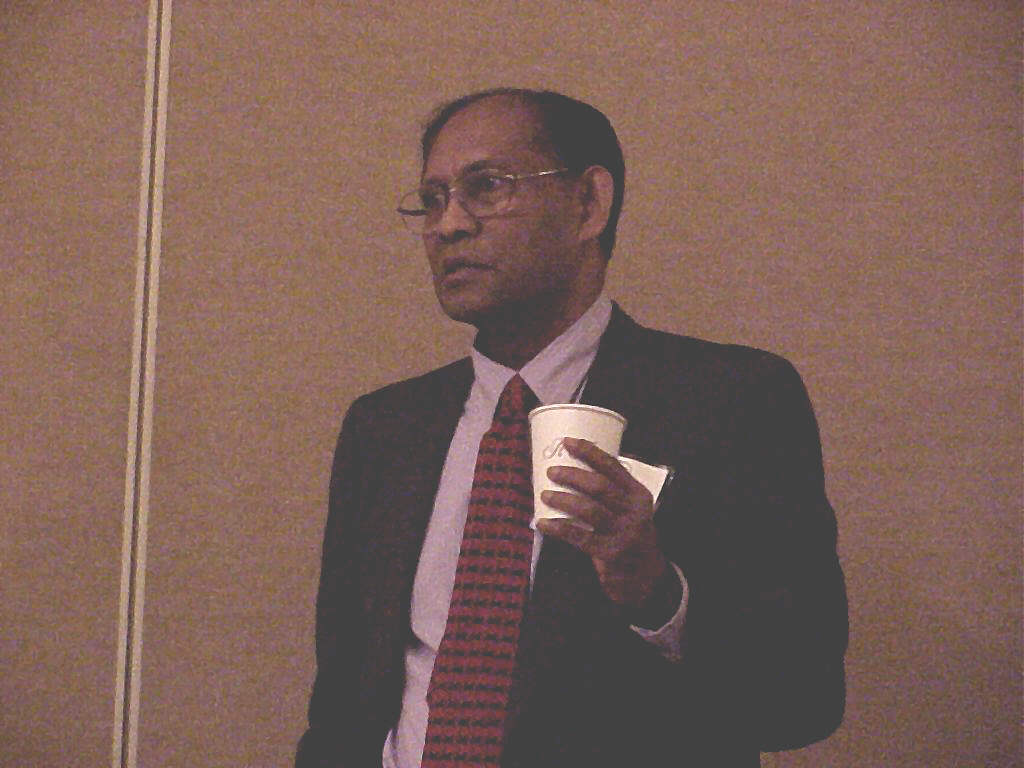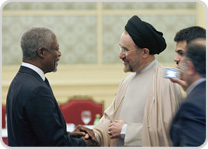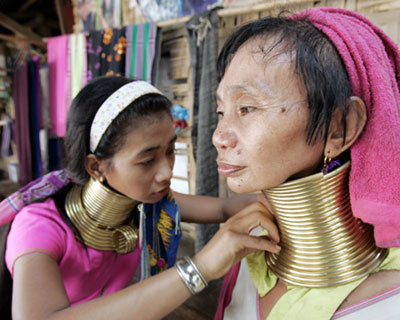
Genghis Khan, the creator and Leader of the Mongol empire, was born around 1165 (dates vary wildly), and died in August 1227.
BiographyAt the time of the rise of Genghis Khan, the Mongol tribes were disunited. They had a fiercely independent nature, a strongly held system of social rules, and were essentially shamanistic in religious beliefs. Their nomadic existence meant they relied on barter rather than money, but because of long standing in-fighting between the tribes, they were economically poor. Stories of eating "anything that moved" and even of some cannibalism in hard times persist.
Politically, whilst the Mongols clearly recognized their own tribal connections and blood ties, there was no "Mongol Nation".
The Tartars to their east, and the Keraits to their immediate west were enemies of the Mongols. To the south-west were the Uighurs, and due south, the Chinese Chin dynasty was well established. The Chin were powerful enough to extract dues of various kinds from their northern, nomadic neighbors. And, to the far west, stretching to the Black Sea, the Islamic Sultanate of Muhammad of Khwarazm prospered.
The times were cruel, with execution being the usual punishment for transgressions. Wars were fought with no mercy for the opposing army. Slavery was the norm for conquered peoples. On the other hand, the Mongols had an intense sense of loyalty, hated theft, had a history of the acceptance of the beliefs and the way of life of others, and tended to be generous to people they trusted.
Not surprisingly, this background helped shape Temuchin, who later became Genghis Khan.

ConquestsTemuchin's first major patron was Toghrul, of the Keraits, who he saw as an adopted father. Toghrul was probably the strongest leader amongst the Mongolian tribes at that point, although he was constantly under threat both externally and from family infighting. When Temuchin's wife Börte was abducted by the Merkits, Toghrul and Jamuka (Temuchin's blood brother, his "anda", and eventually his enemy) helped rescue her (1183/84).
But not everything went Temuchin's way, with a major defeat in 1187 leading to almost a ten-year gap in his life history, until 1196. That year Temuchin successfully attacked the Tartars. He then rescued Toghrul from exile, who was given the Chin title "Wang Khan". Jamuka declared against Temuchin in 1201, when he was elected "Gurkhan". In 1202 Temuchin exterminated the Tartars, and that year Wang Khan broke with Temuchin. Thus, and perhaps inevitably, Genghis was at war with the Keraits.
In 1203 Wang Khan died, and Genghis assumed his title of King of the Keraits. Jamuka was betrayed to Temuchin, and died in 1205. Thus the stage was set for Temuchin to be elected "Genghis Khan", over all of the Mongolian tribes, in 1206.
In 1209, the Uighurs submitted to Genghis, leaving him free to concentrate on the Chin and to refuse to pay tribute to them. Eventually, after many battles and even a withdrawal to Mongolia, Genghis destroyed Zongdu in 1215. This was the Chin capital (later to become Beijing), so the Chin capital moved south to Nanking (Kaifeng).
Treacherously, and somewhat stupidly, soldiers of Sultan Muhammad of Khwarazm killed ambassadors from Genghis, forcing him to declare war on that Islamic empire in 1219. Genghis won in 1221. His Empire stretched from the Korean peninsular almost to Kiev, and south to the Indus. It was the largest land empire ever seen.
Genghis was thus now able to focus his time on establishing an effective administration of the Mongol Empire, whilst keeping internal strife under check and setting his succession in place.
He died in August 1227 (the cause is not certain), having named one of his sons Ogödei Kha'an his principal successor. Ogödei is remembered by history as probably the most principled of the sons, explaining Genghis' choice.
Genghis' youngest son Tolui (by all accounts the cruelest of his sons) was not chosen - but Tolui's son became Khubilai Khan, later the first Yuan Emperor of China.

ValuesGenghis Khan's value system was visible to all, and he certainly "walked the talk".
He totally shared his people's belief in the nomadic way of life, recognizing that, in war as in the hunt, booty is the main aim... and winning was what counted. However, amassing material wealth did not matter much to him, as he shared everything with his loyal supporters. He was seen as a most generous Leader.
As an individual, he wanted power. He was a physically strong man, although he was probably not a "hero" in the sense of an outstanding hand-to-hand fighter. He encouraged his supporters to be frank and speak without ceremony, and usually moderated his passion and anger with thoughtful responses.
Genghis also demonstrated a rather liberal and tolerant attitude to the beliefs of others, and never persecuted people on religious grounds. This proved to be good military strategy, as when he was at war with Sultan Muhammad of Khwarazm, other Islamic Leaders did not join the fight against Genghis - it was instead seen as a non-holy war between two individuals.
Whilst Genghis was himself illiterate, he understood the power of spreading ideas via the written word, and used it to administer his empire. He was responsible for the spread of the Uighurs script as the common Mongolian alphabet. He was relentless in learning new things, absorbing ideas from other cultures as often as he could.
Against his enemies, vengeance was a constant theme, reflecting his Mongol cultural heritage, and he slaughtered people with ease. Terror was always one of his principle weapons of war. He laid waste to entire cities and populations that resisted his armies, although he often by-passed others that submitted.
He was clearly most perceptive about politics in rival tribes and cities, and he understood what drove individuals. Usually his strategies involved finding psychological ways to undermine his enemies, based on these perceptions
On the other hand, he recognized the values of his individual enemies. He would put to death a soldier who had tried to be disloyal to their own commander, by, for example, betraying the commander to Genghis. However, he would pardon and even bestow honours and responsibility on those who had fought loyally for their commander - even if against Genghis. In fact one of his most trusted generals, Jebe, was once a young opposing soldier who shot Genghis' horse from under him in battle.

Envision
Genghis Khan actually used the 4 E's of Leadership, even if he didn't know it!The vision was one of economic prosperity for his people, power for himself, total destruction of his enemies and fairness for willing subjects.
At the beginning it is doubtful that he had a grand vision of building the World's biggest empire. Rather, he recognized that rich plunder was the best means of preventing the Mongol tribes from fighting each other. He also recognized that this would allow them to preserve their nomadic way of life.

EnableHis enablers included good use of military technology, a unique organization of his army, promoting leaders on merit not lineage or family, definite rules of engagement in war, and a clear administrative system for conquered peoples.
Whilst his army had no unique weapons, he put to good use the short horse stirrup, to give better control at close quarters. His elite troops were quite heavily armored, although others were more militia-like. His soldiers used the Central Asian compound bow, which had the power of a European crossbow (although they didn't know it), whilst being half the size of a long bow.
He organized his army into units of "ten thousand", not sorted by tribal affinity as was historically the case. This reduced the possibility of internal friction. He also had an elite "Household Guard" with hand-picked commanders, upon which he relied for the most difficult tasks. All of his officers were instructed never to abuse their soldiers.
Rules of engagement were clear to all, and rigorously enforced. For example, if a soldier deserted his troop, he was executed. If a soldier failed to stop to help a fellow warrior whose baggage fell from his horse, he was executed. If two or more members of a troop made a great advance, but were not supported by their comrades, the latter were executed. And so it goes on ...
In terms of battle strategy, it seemed that there was little unique about Genghis' approach, building as it did on the Mongolian way of hunting. He also tended to close in on the enemy only when he was sure of overwhelming them - although he did loose some battles, even then. It seems that the thoroughness, fierceness, courage and total dedication of his troops were what carried the day.
In peacetime, Genghis developed unique administrative organization structures, designed to pre-empt feuding. the unit was not the tribe, family or aristocracy - but based again on tens, hundreds and thousands - "mixed and matched". Leadership was, as ever, based on merit. And he organized a system of internal communication by horse riders. (As an aside, the way some of these riders behaved caused much distress to the populace. They were accorded first right to virtually anything they wanted from local people as they rode across the country, and often abused this right. Genghis was not perfect in his adminstration ...)
Genghis' legal code (The Yasa of Chingis Khan) was firmly based on Mongol common law, but written down and extended as cases arose. And, as for his armies, the rules were clear and tough. For example, theft of any kind led to execution, and adultery was also punishable by death for both parties. He also rigorously enforced the Mongol religious taboos, although as noted before his administration was tolerant of other people's beliefs. On the downside, it should be noted that the continual pursuit of booty and plunder meant that many valuable artifacts were destroyed as he conquered, both religious and otherwise.
In no way am I trying to justify the more uncivilized of these rules .. but I simply want to point out that the clarity and universality of Genghis' rules ensured that his empire worked.

EmpowerIt may be difficult to see that a Leader as strict as Genghis practiced "Empowerment". However if we define "Empowerment" as a contract between a leader and his followers for mutual trust and accountability, it was certainly central to Genghis' approach.
Merit was Genghis' guiding principle in choosing his leaders, both in wartime and when at peace. He did use the noble group as commanders, but his most valuable generals were solely picked on merit. He trusted these people to get the job done, although he clearly held them accountable for results.
The army units were led by commanders personally picked by Genghis. His commanders could be from his immediate family, lowly sheep herders, or even conquered warriors he trusted and respected. Commanders were expected to have their troops ready for battle at all times - else they were replaced. All of the soldiers from whatever rank thus literally had the possibility before them of becoming commanders, based on their own merit.
Next, the Mongol army fully agreed with the goals of their Leader, and accepted the rules under which they fought. They totally trusted Genghis, and would rather die than let him down. In that sense, empowerment was clearly at work.

EnergizeIt seems clear that Genghis was consistently reflecting the real desires of his followers. He unleashed their need to escape from a poverty cycle, rather than simply focus them on visions of world conquest. Then, he made the "enemy without" the tool to prevent internal conflict.
It is perhaps most difficult to assess exactly how Genghis Khan energized his people, as almost no speeches are accurately recorded, and he himself could not write. However, "The Secret History" and several Persian chroniclers provide a few clues.
Whilst Genghis sought power for himself, he also was careful at every stage to offer his followers major gain from their conquests. He shared his animals, his clothes, his food and his plunder with his people, almost irrespective of their social position.
He constantly demonstrated his loyalty to his trusted people, and his generosity surely encouraged all to follow. Rules were clear, rewards were many, and merit was a guiding principle of his administration.
When he went into battle, he very clearly intended to win. His people knew they followed a winner. Even in matters of vengeance, or of being insulted (as was the case with Sultan Muhammad), he very obviously put things in terms his followers could deal with and act upon.
Finally, he was totally true to his own value system, in a way that was obvious to both his friends and his enemies. This in itself must have provided significant energy to his followers.

AftermathGenghis Khan forged the unification of the Mongol tribes, and reversed their decline in living conditions.
Trade flourished, and contact with distant lands, including Europe, was encouraged. He set in motion the events that created the World's biggest land based empire, including the creation of the Yuan Dynasty in China. Importantly, his firm stand on his society's ethical rules and his intolerance of misdeeds led to a marked change in the social climate. Inter family rivalry all but disappeared, and peace and order were very evident to outside visitors, including European travelers.
As Microsoft Encarta says:
"The greatness of the khan as a military leader was borne out not only by his conquests but by the excellent organization, discipline, and maneuverability of his armies. Moreover, the Mongol ruler was an admirable statesman; his empire was so well organized that, so it was claimed, travelers could go from one end of his domain to the other without fear or danger".Or, as in the introduction to the Genghis exhibition at the Royal British Columbian Museum said:
"Genghis Khan pledged to share with his followers both the sweet and the bitter of life. In structuring his army, he integrated soldiers from different tribes, thus inspiring loyalty to the Mongol army as a whole rather than to a specific lineage. He gave his enemies one simple choice: surrender and be enslaved, or die. By consistently enforcing discipline, rewarding skill and allegiance, and punishing those who opposed him, Genghis Khan established a vast empire".For the people he conquered, the impact was very mixed. The Chinese fields got turned into nomadic pasture, adversely affecting the Chin peasants and causing hardship. On the other hand, for the cultures that he and later Khubilai Khan ruled, like the Chin, the encouragement of the exchange of knowledge and ideas helped them develop. For example, the Chinese became acquainted with Iranian medical knowledge and astronomy, and in return the peoples of the Middle East learnt much from China.
Unfortunately, unlike earlier days, increased prosperity meant that the lifestyle of the Mongol nobles tended to edge too far past that of the commoners. And, the sheer size of the empire and the extent of the losses in Mongolian manpower meant Genghis' empire was stretched thin.
Finally, recall that warfare and booty was the order of the day for the nomadic existence. So, in gaining a stable empire, the Mongols had to get used to the money economy. And, just as the administration came under control, so the administrators themselves became less militarily capable, and more intent on self-gain.
It was perhaps inevitable that, on his death, the empire was destined to split between his three remaining sons. Eventually, though, four Mongol Leaders became great Khans in their own right. It is a tribute the the memory of Genghis Khan that they did not war between themselves - rather they linked co-operatively together in separate Khanates to "rule the world".
Perhaps the most important Khan was Khubilai, who founded the Chinese Yuan dynasty. This dynasty flourished from from 1279 to 1368, and had a lasting effect on all aspects of Chinese life.
It is thus very clear that Genghis was a Leader with a "capital L".Copyright 2003-2006 Azlan Adnan Legal Notice
















/Y.B.%20Dato%27%20Haji%20Zainal%20@%20Zakaria%20Mat%20Deros.jpg)

























